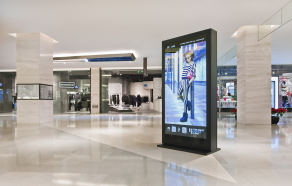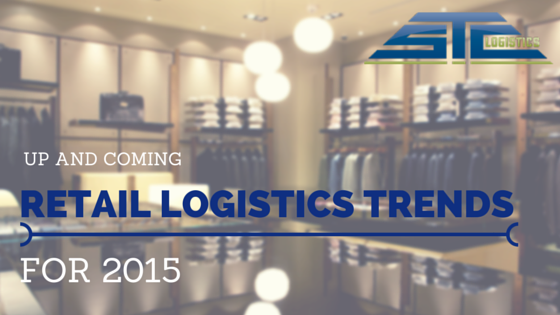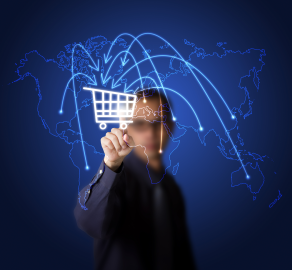Category: Retail News
2016 Retail Sales Predictions
The National Retail Federation (NRF) released its economic forecast for the year, projecting that retail industry sales will grow 3.1%, higher than the 10-year average of 2.7%. The NRF also announced that it expects non-store sales in 2016 to grow between 6% and 9%. These predictions exclude purchases related to automobiles, gas stations and restaurants. Read more of the forecast here.
4 Ways to Grow Your Global Ecommerce Retail Company
It’s not an easy process to develop a global ecommerce shopping platform for your retail business. Retailers understand that everything begins with the consumer; they are the ones who go through the shopping experience from start to finish and with an ever-increasing amount of interruptions during the buying process, retailers must adapt to survive and thrive.
MultichannelMerchant.com provides four tips for retailers to grow their global ecommerce business here.
2015 in Review for the Logistics and Transportation Industry
Another year is in the books, and we’re now deep in the first quarter of 2016. While it’s evident that the logistics and transportation industry experienced a rapid pace of change in 2015, there were many other strong trends that resonated above typical predictions for the year, such as plummeting fuel prices and more. Click here to read Logistic Management’s list of the top stories and themes of 2015.
As Retailers Look to Add Value, 3PL Solutions Meet the Need

Smart retailers leverage numerous channels to provide the best possible experience for customers. It’s not a new idea anymore, and to meet the needs of today’s consumer, you need to understand where they live both online and in-person.
Research tells retailers what messages are needed for online shoppers versus brick-and-mortar guests, but at some point, the store needs to acquire the ability to deliver product where the customers live in their own little shopping worlds. So while your marketing spreads out to all the places where customer hangs out, the logistics function needs to be equally as agile.
The role of the 3PL in this diverse supply chain
More channels and delivery methods means a more complicated process that needs to be managed. This can lead to added costs and potentially expensive mistakes if the supply chain management is not reliable.
Strategically, the execution of the supply chain function is the heart of the retail business. If the business can’t deliver, it can’t collect the money on the product.
Make the investment! – If the heart of your business needs attention, don’t cut corners. You wouldn’t look for a do-it-yourself option for your own heart and you shouldn’t try to pull that off the heart of your business.
Who is there if something goes wrong? Considering all the responsibilities put on your staff already, time for fixing supplier issues just doesn’t exist. Enlisting the help of a resourceful 3PL partner can certainly lighten this load and put it back where it belongs — with the supplier. Many times the supplier and 3PL can anticipate an issue and make it disappear before anyone involved with the retail business is even aware. A vanishing issue is best kind of issue.
This illustrates a role the 3PL can assume and become a true partner of the business.
One eye on costs – Shipping and final delivery costs are anything but static and, for many retailers, the cost of shipping can even exceed the cost of the product being shipped. A well-established 3PL service can analyze into the future, anticipate a rise in shipping charges due to outside pressures and make decisions to mitigate the increase. They actually bring expertise in contract negotiation and management to your team.
At the very least, the 3PL provider can give some advanced warning in time to make a price adjustment or shift to another delivery method.
Complete services – The white glove 3PL can add as much service or as little as needed. When new stores open or capital improvements are being made , it’s well worth the cost to have a logistics provider deliver, set up and haul away waste from the shop so store managers and employees can move right to sales.
A wealth of service from a single provider is exactly what STC Logistics can bring to your business. If you’ve been considering adding a complete logistics and supply chain management service to your operations, take a look at our specialties today by clicking below!
Using Social Media to Boost Fragrance and Cosmetics Retail Sales

The cosmetics and fragrance industry enjoys success with a well-established foundation built over decades. As other well-established businesses struggle through the internet age, cosmetics and fragrances can take advantage of the opportunity to actually thrive. And they are thriving.
Cosmetics and fragrances typically enjoy high margins and low ship-to-weight ratios, making this a great industry for e-commerce and that’s the end of the funnel as companies work to pass customers through social media, right?
Retail fragrance and cosmetic companies are aware of the value of social media and must continue to evolve with the ever-changing platforms to keep ahead of competition.
Social media, research and decision making
Don’t think about research in the same boring way a scientist in a lab might approach the topic. Buyer research in the cosmetics industry (and many others) takes place in the form of simple conversations. The ability of a cosmetics or fragrance company to provide and respond to a channel can have a huge affect on sales.
Feedback forums and social platforms offer customers a place to go if something is not right or if they have a question. While this may not be directly transactional, customers who use responsive forums will feel more secure with their purchase knowing they can ask questions. This can play a critical role in shaping the transactions going forward.
Extending reach with product endorsements
Another age-old and successful strategy for the cosmetics industry involves the product endorsement. Long ago movie stars, singers and other beauties have endorsed makeup and fragrance to boost sales. This strategy continues to work well.
Social media only serves to amplify the product endorsement as now the company can leverage their own media channels in addition to the channels owned and updated by the superstar endorser. The online audience can quickly expand by millions with the addition of the right person.
Those imminently recognizable figures have also helped extend reach through video channels such as YouTube. Those classic television spots still matter, but again, successful companies such as L’Oreal see no reason to stop with traditional commercials when they can keep extending their reach and start a conversation with potential customers while they watch videos.
As annoying as it may be to some, there’s even the potential to gain the endorsement of the “social media celebrity.” Yep, we’re touting the value of the Kardashians and it makes sense. Celebrities with an excess of 16 million followers on their social media channels offer an attractive endorsement. Kendall Jenner and her famous sisters give big companies the chance to simply buy followers (and a lot of them) rather than jumping in and competing in the same crowded space. It could take years for a cosmetics brand to drum up that type of following.
Utilizing Paid Advertising Opportunties
Social media platforms such as Facebook and Twitter offer user-friendly paid advertising opportunities to businesses of all types—but these opportunities are especially effective for the retail world. Fragrance and cosmetics retailers can use paid ads to increase their following on social platforms, drive traffic to their websites, build buzz about a product or sale. These platforms allow you to run ads based on detailed demographic information to ensure the ads are reaching the right audience—and then gives you insight as to how ads are performing to continuously improve campaigns.
STC Logistics specializes in logistics services for retailers such as fragrance and cosmetics companies. To learn more about our retail logistics services, click below!
Up and Coming Retail Logistics Trends for 2015

Up and coming retail logistics trends show a global shift in the movement of goods and services. Developing countries are now challenging countries that were once recognized as leading the world in consumers spending and consumption. Here are retail trends that are expected for the remainder of the 2015:
1) Heavier Competition
Developing markets offer goods and services for developing lands. Goods are in demand by countries once unable to afford durable goods. Manufacturers are courting consumers of these nations and their newfound wealth. Consumers are offered different avenues for shopping, placing pressure on sellers to work harder to draw and hold present customer base. This requires consistent improvement of retail logistic strategy and solutions.
2) Increase in Supply Lines
Retailers and manufacturers are using multiple currency applications and better merchandise supply lines. Supplying a reliable product the first time around is more important than ever. Merchandise reaches customers in a few days rather than weeks. Sellers competing with businesses with local distribution networks must search for benefits that set them apart and give a buyer a motive to wait extra time for merchandise. Companies refusing to recognize the way money is moved from one global point to another cannot operate effectively. It is more important than ever to have a reliable logistics backing in todays “instant gratification” culture.
3) Increase in Online Purchasing
The internet launched a major change in retail logistics. Those realizing the advantage quickly took primary spots in front of the consumer, such as Overstock and Zappos. The introduction of internet purchasing changed retail logistics even further. Businesses operated by one person or small groups are now able to advertise and sell to global markets, ship merchandise and cut into a percentage of the GDP. Globalization is a possibility for anyone.
Internet shopping is increasingly done more on mobile devices. The most recent trend is new source in mobile technology: shopping apps. Customers can download shopping apps on phones and checkout with any number of payment options. Prosperous businesses have fallen along the wayside if they haven’t yet adopted this technology. More than 50% of online shopping is currently done through mobile apps. Future expectations expect the present 4 billion shopping app dollars to expand to a fast 200 billion. Presently, 78% of people searching with a mobile app make a purchase.
4) Cheaper Costs for Major Transportation
Companies around the world now have access to major transportation outlets. The ability of companies to ship small and large loads economically from every part of the globe allows any merchant to transport goods. Merchandise is constructed, stored, packaged and shipped in a refined operation—specifically when outsourcing logistics needs to a third-party logistics (3PL) provider. Logistics providers offer retailers and customers peace of mind by providing currency alternatives, inventory management and product tracking. When it comes to retail logistics practices, this is a selling mechanism. A reliable 3PL can provide customers payment arrangements that suit their bookkeeping methods that ultimately aid in sales.
In large business operations from developed nations, owners may know how long merchandise will take to get to a destination as well as transportation cost and has a strong network of carriers and 3PL’s to manage products. The use of a 3PL provides manufacturers from less well-known destinations the opportunity to compete in an economy once dominated by larger countries and allows larger businesses to maintain control.
5) Information Flow Integration
Access to information allows buyers to reach into a new pool of prices. Older manufacturers may be able to present a lower price of quality merchandise but others may sacrifice profit to break into the market. A smaller company may have less overhead enabling it to compete with mainstream producers. Knowledge of the market that consumers work and buy merchandise in is essential. Reliable export and packaging information can be easier to find. This added step helps trust in dealing with a provider of merchandise and is an asset in retail logistics operations.
Material handling, production, packaging, inventory, warehousing and security are all important aspects of retail logistics. If a retailer’s freight is not distributed and delivered with accuracy and safety, they risk the cost of operation and profit. Retailers can rest assured that they are maximizing productivity and profit when employing a third party logistics (3PL) provider. STC Logistics specializes in reliable retail logistics, export assembly services and import distribution solutions that can ensure an efficient supply chain. Whether coming from multiple vendors or going to various destinations, from inventory, warehousing and delivery requirements, STC Logistics warrants product to its final endpoint. Click below to learn more about our fast freight retail shipping services!
To receive updates for our logistics blog, subscribe at the top of the page!












